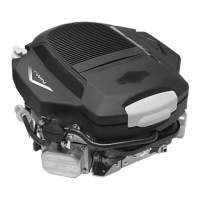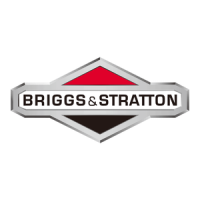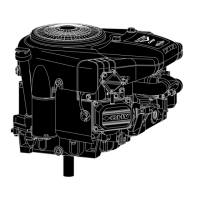How to get help with my Briggs & Stratton 400000 Engine?
- AAshley PruittAug 3, 2025
If you require assistance with your Briggs & Stratton Engine, you can contact your local dealer, visit BRIGGSandSTRATTON.COM, or call 1-800-444-7774 (in USA).




How to get help with my Briggs & Stratton 400000 Engine?
If you require assistance with your Briggs & Stratton Engine, you can contact your local dealer, visit BRIGGSandSTRATTON.COM, or call 1-800-444-7774 (in USA).
How to prevent fuel leakage when replacing fuel filter in Briggs & Stratton 400000 Engine?
To prevent fuel leakage during fuel filter replacement in your Briggs & Stratton Engine, drain the fuel tank or close the fuel shut-off valve.
Why does my Briggs & Stratton 400000 Engine overheat?
Your Briggs & Stratton Engine may overheat due to several reasons. Accumulated debris can restrict airflow, causing the engine to overheat. To resolve this, use a brush or dry cloth to remove debris from the air intake grille. Also debris can accumulate in the cylinder cooling fins and cause the engine to overheat. Have a Briggs & Stratton Authorized Service Dealer inspect and clean the air cooling system as recommended in the Maintenance Schedule. Make sure the oil cooler fins are free of dirt and debris. Keep linkage, springs and controls clean. Keep the area around and behind the muffler free of any combustible debris.
Explains safety symbols and signal words like DANGER, WARNING, CAUTION.
Provides meanings of hazard symbols for personal injury.
Details warnings and precautions for fueling, starting, and operating the engine.
Compares callout letters to engine controls for operation.
Explains symbols used for engine start, stop, and speed settings.
Provides guidance on oil types, viscosity, capacity, and low oil protection.
Details fuel requirements, high altitude considerations, and fueling procedures.
Outlines safety precautions and steps for starting the engine.
Explains starting procedures for EFI, Electronic Fuel Management, and Choke systems.
Provides instructions and safety warnings for shutting down the engine.
Covers general maintenance advice, including tilting and cleaning precautions.
Details service actions, intervals, and corresponding oil filter types.
Addresses emissions control service, EFI, fuel management, and carburetor maintenance.
Guides on servicing the spark plug and exhaust system, including safety.
Covers procedures for removing, draining, and adding engine oil.
Details steps for replacing standard and Oil Xtend oil filters.
Explains how to service air filters, including cyclonic types.
Instructions for servicing the fuel filter and related components.
Guidance on cleaning the engine's cooling system to prevent overheating.
Information on obtaining assistance and detailed engine specifications.
Lists common service parts and their part numbers for various models.
Details how engine power ratings are determined and factors affecting them.
Outlines the limited warranty terms, coverage, and exclusions.
Explains owner responsibilities and warranty coverage for emissions control systems.
Details specific warranted parts, coverage length, consequential coverage, and exclusions.
Explains emissions durability periods and air index information for certified engines.
Explains safety symbols and signal words like DANGER, WARNING, CAUTION.
Provides meanings of hazard symbols for personal injury.
Details warnings and precautions for fueling, starting, and operating the engine.
Compares callout letters to engine controls for operation.
Explains symbols used for engine start, stop, and speed settings.
Provides guidance on oil types, viscosity, capacity, and low oil protection.
Details fuel requirements, high altitude considerations, and fueling procedures.
Outlines safety precautions and steps for starting the engine.
Explains starting procedures for EFI, Electronic Fuel Management, and Choke systems.
Provides instructions and safety warnings for shutting down the engine.
Covers general maintenance advice, including tilting and cleaning precautions.
Details service actions, intervals, and corresponding oil filter types.
Addresses emissions control service, EFI, fuel management, and carburetor maintenance.
Guides on servicing the spark plug and exhaust system, including safety.
Covers procedures for removing, draining, and adding engine oil.
Details steps for replacing standard and Oil Xtend oil filters.
Explains how to service air filters, including cyclonic types.
Instructions for servicing the fuel filter and related components.
Guidance on cleaning the engine's cooling system to prevent overheating.
Information on obtaining assistance and detailed engine specifications.
Lists common service parts and their part numbers for various models.
Details how engine power ratings are determined and factors affecting them.
Outlines the limited warranty terms, coverage, and exclusions.
Explains owner responsibilities and warranty coverage for emissions control systems.
Details specific warranted parts, coverage length, consequential coverage, and exclusions.
Explains emissions durability periods and air index information for certified engines.
| Governor Type | Mechanical |
|---|---|
| Air Cleaner | Dual Element |
| Fuel Shut-Off | Yes |
| Low Oil Shutdown | Yes |
| Fuel Tank Capacity | 3.8 L (1.0 gal) |
| Spark Plug | Champion |
| Starter Type | Recoil |
| Carburetor | Float Feed |











